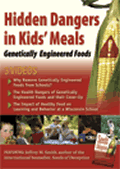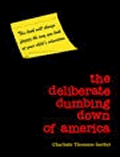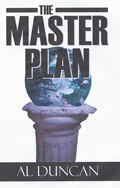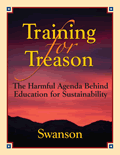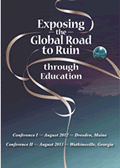COLORING
THE COMMON CORE GREEN
PART 2
By Sam
Anderson
February 7, 2015
NewsWithViews.com
Agenda 21’s stake in the Common Core Standards in Oregon
How might Oregon integrate the Common Core with the great outdoors? Government has a high percentage of control over Oregon land, so students only have to step outside to be naturealized citizens. Oregon's No Child Left Inside Act (OR HB2544 -2009) assures longer recess times and doesn't seem to mind the outside forces controlling your child’s schooling. Education for Sustainability wants to take your child for more than a walk.
Who is taking my child for more than a walk?
“The Governor appointed an eleven-member Oregon Environmental Literacy Plan (OELP) task force leaders Traci Price, a Steering Committee member for The Sustainable Oregon Schools Initiative and the Oregon’s representative of the North American Association for Environmental Education and Lori Stole a Committee member of the US Partnership and lead in Zero Waste Alliance. Task force members hailed from the “Oregon Department of Education, Oregon University System, Environmental Quality, Fish and Wildlife, State Lands, State Marine Board, Parks and Recreation, Forestry, and Agriculture; The Freshwater Trust; The Environmental Education Association of Oregon, and Metro Regional Government. The task force met regularly from January to September 2010. At various times throughout the process, small working groups were formed to accomplish specific tasks related to the development of the Plan” (see Appendix A for a complete list of participants).
What
purpose is there in taking a walk outside the school?
“It offers a way to extend young people’s attention beyond
the classroom to the world as it actually is, and to engage them in the
process of devising solutions to the social and environmental problems
they will confront as adults.” (pg. 42)
However, the Oregon Environmental Literacy (EL) Plan chose not to offer the whole truth. They failed to mention in the plan that the US Partnership’s mission is to “Leverage the UN Decade to foster education for sustainable development in the United States.” They failed to mention the use of Cloud Institute’s indicators to create ‘systems thinkers’.
How does my child’s school fit in with this plan?
From the homepage of the Sustainable Schools Collaborative it clearly states that it manages the Sustainable Oregon Schools Initiative (SOSI) having a 3 step process that schools can utilize in implementing Education for Sustainability (EfS), sustainable practices, policies and standards.
What is the Collaborative’s agenda for my child?
The Collaborative’s answer: “The United Nations Education for Sustainable Development: Agenda 21, the plan developed at the Rio Earth Summit, included an implementation section which delves into education for sustainability: Chapter 36, Promoting Education, Public Awareness and Training. Education was considered to be so important that it was the only means singled out in 2002 for a United Nations Decade. . . The U.S. Partnership for the UN Decade, was founded in 2003. It is a grass roots movement working outside of federal government policy and priorities. It is managed by an executive team, and built on the work of actions teams and sector teams including higher education, K-12, faith community, youth and living institutions.”
One member of Oregon’s Dept. of Education found inspiration to create a toolbox to connect schools to their communities. McKeown’s idea for a ESD toolkit came after attending a UN meeting in 1998. The Commission on Sustainable Development (CSD) mission is to “review several chapters of Agenda 21.” Chapter 36 was on the docket, “Promoting Education, Public Awareness and Training.”
One reason you may not have heard of Agenda 21 is found in Section 31-10 “Countries and the UN system should promote a cooperative relationship with the media. . . to mobilize their experience in shaping public behavior.” Distorting the shape of their message worked so well that some Southern Oregon legislative Representatives recently denied even hearing of Agenda 21. If you are aware of ‘smart growth’ you are looking at Agenda 21.
Will my child have a better education if my school is participating?
In the Collaborative’s opinion, “Currently the most educated societies are leaving the deepest ecological footprints. If all societies were to develop in the same way it would require FOUR EARTH’S, which would seem to indicate that education needs to be re-oriented.” The point of re-orienting education for sustainability is to reduced, nip in the bud, re-educate, indoctrinate, or if you please dumb down American students to heal the planet.
Oregon is home to several especially privileged partners who are leading children to tread lightly on their walks. Following the ecological footprints of UNESCO in guiding Agenda 21 into classrooms is Bora Simmons, author of one the “guidelines for excellence” recommended by the Environmental Education Association of Oregon, which happens to be an arm of the NAAEE (see Part 1). Quoting from the Guidelines for K-12; “The values clarification approach helps students become aware of personal beliefs, attitudes, values and behavior which they prize and are committed to both in and out the classroom. This process assists students in considering alternative solutions and the implications of each alternative.” (pg. 92)
Excellence is nowhere to be seen in Bora Simmons’ guideline. No mention of the principles of any type of science or mathematical skills. No mention of reading comprehension, nor language arts in the construction of well written compositions. Civics? Yes – the creation of civic minded activism, But no trace of scholarly achievement. Merely awareness of environment, “evaluating public policies related to resource use, how groups meet group goals and the common good, identify ways in which others’ views correspond or differ with their own views, explain international trade in terms of uneven distribution of resources and based on stories from other cultures, script and perform scenes about what is considered beautiful, valuable, or frightening in the environment, analyze the role of private property rights, evaluate the structure and functions of the United Nations and its agencies in addressing global environmental issues . . . . ad nauseam throughout 120 pages.
The states consorting with the ‘EE 2000’ project, linked the globalist’s vision, addressed in Agenda 21, to local communities. Chapter 36 is specifically geared to education, and the best illustration of its intent can be gained by studying the “Sustainability Indicators Project, spearheaded by Rescue Mission: Plant Earth, an organization with affiliates throughout the world” (pg. 26). Rescue Mission: Planet Earth was propagated by Peace Child International, a child’s version of Agenda 21. Indicators are the red flags of environmental injustice; air and water pollution, endangered species, poverty, climate change, consumerism, biodiversity, racism, a wealth of controversial issues for the young to monitor and analyze.
Rescue Mission: Planet Earth “The original Agenda rambles on for 500 pages and 40 chapters about a $600 billion program to save the planet. What we've done is to put it into a language that ordinary people can understand.” How generous in simplifying Agenda 21 for us common folk. Follow the link to the Goodman Chronicle to download the children’s version of Agenda 21 and Good Man’s extraordinary expose.
This sounds like extreme environmentalism for kids. Is our government sponsoring this also?
The Collaborative directs you to UNESCO’s role in the development of the United Nations effort to “integrate the principles, values, and practices of sustainable development into all aspects of education and learning, in order to address the social, economic, cultural and environmental problems we face in the 21st Century.” The United States government participated “through the US Partnership, which includes a K-12 and Teacher Education Sector Team.”
How
is this going to change my child’s education? Will a new course
be required?
The Collaborative hosts the sources of content your child will learn,
standards from the Cloud Institute’s core content areas and the
US Partnership Sustainability Standards for Grades K-12 are reflected
in Oregon’s
Environmental Literacy Strands, detailed in Chapter 3 of the OELP.
On behalf of the Collaborative; “The international implementation plan for the Decade asserts that Education for Sustainable Development (ESD) should not be equated with environmental education, but rather encompass it and go beyond it, or that ESD cannot be taught as an independent subject, but should be infused throughout the curriculum and the disciplines.” So teachers will have some explaining to do when students ask what Oregon means when a student is to “identify and define reinforcing and balancing feedback loops within a system, or track existing causal relationships. Will parents need to learn the Archetypes: Fixes that Backfire, Shifting the Burden, Tragedy of the Commons, or Healthy Commons archetypes.
I thought
Oregon had adopted the Common Core State Standards.
Oregon has released their first version
of infusing sustainability standards with the Common Core, a so named
‘living document’, ripening for changes in the future. You
only need to scan the table of contents to find Connecting Environmental
Literacy and the Common Core Standards for English Language Arts and for
Mathematics. What Oregon calls ‘environmental literacy’
can best be explained by the authors. “Education must equip students
with knowledge, skills, understanding, attitudes and values compatible
with a sustainable society. It goes beyond the “green” agenda
to raise awareness of the complexity and dynamism of issues. It builds
capacity for collaboration and creativity in problem-solving, critical
reflection and systemic and futures thinking, a trans-disciplinary orientation,
and motivates action for environmental sustainability.” The document
attributes its contents to none other than Bora Simmons, assuring a stake
in the “guidelines for excellence” content mentioned above.
The 3 modes of thinking for problem solving quoted here are critical reflection (aka critical thinking) emphasized over any other types of thinking. Systems thinking is generated from General Systems Theory and its practicing field of cybernetics, indoctrinating students to making sustainable decisions for the future.
General Systems Theory (aka the Unity of Science) simply describes systems as a set of interrelated parts all working together to achieve a common goal. Cybernetics in the classroom relates education to sustainability whereby all studies are purposed to sustain the self-healing system of life on earth. A community, in this case a classroom, would contribute to this ‘living earth’ in a closed signaling loop. Oregon’s Environmental Literacy Plan reserved Appendix C on systems thinking which has little to do with the solar or digestive systems and everything about “Our beliefs, assumptions, and ideas about how things work. Mental models are often hidden, even from ourselves (pg. 131) ”The true of nature ‘mental models’ are found on web sites dedicated to revealing the subversive intent of system thinkers. From "World Heritage 'Protection: UNESCO's War Against National Sovereignty"
In the eyes of UNESCO, private owners can't be trusted to guard "a World Heritage which belongs to all humanity" any more than parents can be trusted to raise their own children. The rights of the global collective must replace the old Western individual rights. To persuade the public, a new revolutionary way of thinking-often called holistic, integrated, or "systems thinking" -- must replace the contrary old Western thoughts and ways.”
Recall that it was the Council of Chief State School Officers who mandated the Common Core standards. Their next agenda: “A major effort is underway to develop standards for global/international education. It is headed by the Council of Chief State School Officers, the Elliot School of International Affairs of George Washington University, and the American Forum for Global Education. These standards offer a perspective on what America's youth need to learn about the world, including content areas, skill competencies, and attitudes. They are designed to facilitate the integration of a global/international perspective into existing curricula. The ultimate effect these standards will have on classroom instruction has been debated, but their existence will contribute much to the on-going dialogue about priorities of teaching and learning in schools.”
What schools in Oregon are oriented in Education for Sustainability?
Gladstone School District hails as one district willing to assist other districts in “implementing embedded Sustainability Curriculum in multiple subject areas, Art, Business, Math, Technology, Language Arts, Family/Consumer Studies and Science.” They joined in Portland State University’s consortium for sustainability. “Green School Club representatives also extended their impact to groups off-campus. Students spoke to our local city government as well as the Oregon Sustainability Board about their ongoing work. Club members pressed the governor's office for help in finding high school curriculum on sustainability, as well as resources to help improve our sustainability practices. Gladstone’s work in this area was recognized with the Governor's Sustainability Award in 2010.
Social, environmental and economic lessons match perfectly to UNESCO’s 3 pillars. Any Oregon School having a ‘Green Ribbon Award, or meeting LEED certification is ruled by UNESCO’s guiding document, Agenda 21.
The public is fooled into thinking charter schools can offer children a better alternative. Oregon City Service Learning Academy web site is under re-construction, as 2 years ago their homepage pictured students collecting litter on a beach, cleaning garbage near a stream and piling forest slash, performing their ‘socially useful work’ in a Marxist state.
Democracies are surely efficient and time saving, as Oregon adopted the Common Core State Standards and published the Environmental Literacy Plan in the same month and year - Oct, 2010. Oregon also understood the criteria for an ESD-School early on as Oregon has had a front row seat in every national and international step in transforming schooling. Recently, three representatives from Southern Oregon University served on the editorial board for the 7th International JTEFS/BBCC Conference (2009) on 'Sustainable Development and Culture Education' at Daugavpils University in Latvia. The ‘think globally, act locally' mantra travels long distances, under the radar, quietly spewing its inexhaustive designs into our schools and communities.
Oregon's Environmental Literacy standards for 6-12 grades "are not meant to replace content standards in reading and writing, but rather to supplement them." Supplementing is meaningless, as the Common Core requires 70% informational texts for upper grade reading skills and 50% in the elementary. So parents can be assured they are requisite for Agenda 21’s sustainable education. Remember, sustainable education reaches into the social, economic and environmental realms towards global citizenship. The Common Core’s standards for Literacy in History/Science & Technology is the first phase in integrating all the disciplines. Literacy in Oregon means ‘environmental literacy (EL).
If parents are to understand the challenging vocabulary of environmental literacy, why not just publish the Cloud's indicators or the US Partnership's terminology in the plan and educate the public first, so they can evaluate it. No, Oregon’s task force teams would rather foist it on children first. Their "Note on range and content of student reading," has more to do with reading statistical information and drawing elaborate diagrams than the enrichment of literature, as literature would enhance a student's ability in speaking and writing. Progressives liken the Constitution to a 'living document'. So too, does Oregon's Environmental Literacy task force.
"This is a living document. As teachers and other educators use the crosswalks and provide feedback, they will be revised. Additionally, it is our intention to update crosswalks as the Oregon Department of Education adopts new standards and continues to define the Essential Skills." (OELP)
|
|
This affirms the never-ending dynamic process for schools, described by the Office of Educational Research and Improvement. Surely the People's Democracy of Oregon will lead the states, having an insider's view of our children's future from a global perspective. A proper evaluation of the standards would take more space than this article permits, but there's no doubt on one score - Oregon's plan for 'environmental literacy' is not the most essential ingredient in the program, global literacy is. A literacy designed to sustain a living planet named Gaia. (see Part 3 – Systems thinkers in Ecovillages)
"Nowhere does the battle rage as fiercely as in education. Predictably, the transformation of structure and content in the university filtered down until it had engulfed the entire educational establishment. While every day lip service is paid to the 'crisis' and 'solutions' are debated everywhere, the true purpose of the commissar state is making excellent progress."[1] (pg.232) For part one click below.
Click here for part -----> 1, 2,
� 2015 Sam Anderson - All Rights Reserved
1. America's Thirty Years War, by Balint Vazsonyi, Regnery Pub; Washington D. C. 1998.
As a student, a teacher’s aide and then as a teacher Sam Anderson have always loved the flavor of a classroom. Graduated from Southern Oregon University with a B.S. in Elementary Education, endorsed in Mathematics, subsequently teaching 6th grade and middle school math. Sam began her research on the transformation of our educational institutions in 1995, the advent of Goals 2000. It was a privilege to share her research with a national research group on education issues for 3 years and write for a newspaper. More recently, Sam has given presentations in Southern Oregon and appeared several times as a guest on local Bill Meyer's KMED radio show in Medford Or.. Sam resides in the Rogue Valley, of Southern Oregon.
E-Mail: dlandy414@gmail.com



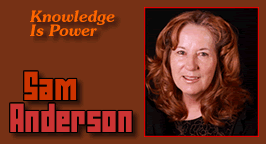



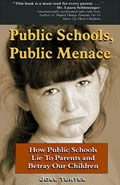






 Share
This Article
Share
This Article
